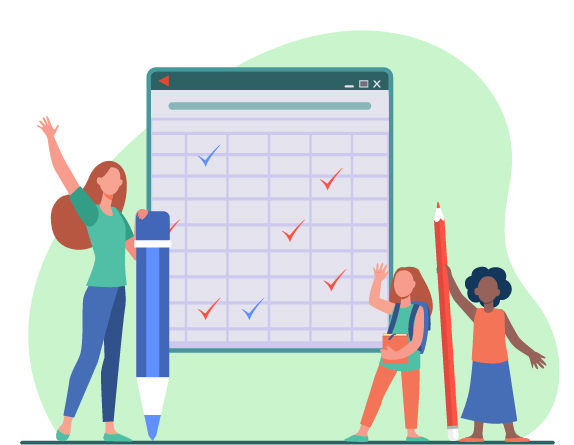The rate at which highly-skilled teachers are leaving the profession is astounding. With so much focus on student learning, teacher learning can become an afterthought. But the two are closely connected, and focusing on the former can help keep great teachers in the classroom. Start by taking a look at your professional development program.
A recent report from the Council of the Great City Schools suggests that high-quality professional development should focus on content, collaboration, feedback, reflection, and personalized coaching and support. The challenges to great teacher led professional development cited in the report were a lack of differentiated options, insufficient support, and inconsistent and arbitrary offerings.
If you are facing any of these challenges, you can use the three actionable steps below to improve your professional development program. Each of the below steps builds on the previous one to create a solid foundation for teacher-led professional growth all year long.
What Is Teacher Led Professional Development?
Simply put, teacher-led professional development is an approach that empowers educators to steer their own learning journey, rather than being passive recipients of traditional professional development. A teacher-led approach encourages educators to actively engage in shaping their own improvement.

This method taps into the insight that teachers possess unique knowledge of their students, classroom dynamics, and curriculum intricacies. Teacher Led Professional Development honors the idea that teachers are experts who can not only identify their needs but also drive the strategies required to meet them. It’s a shift from “one-size-fits-all” to “teacher-centered,” fostering a culture of collaboration and continuous learning.
Benefits of Teacher Led Professional Development
There are ample benefits of the teacher led professional development. Few of them are mentioned below:
- Ownership: Teachers become architects of their growth, enhancing motivation and commitment.
- Peer Empowerment: Collaborative environments foster knowledge exchange and collective improvement.
- Relevance: When teachers have a say in their professional growth, administrators are able to provide more relevant, personalized support.
- Reflection: Encourages self-reflection, leading to conscious refinement of instructional practices.
- Student Impact: Improved teaching directly impacts student learning and engagement.
- Long-term Sustainability: Teacher-led approaches cultivate an ongoing culture of development.
3 Steps of Teacher Led Professional Development
Teacher led professional development steps are vital for fostering teacher growth. We’ve summarized these crucial steps briefly.
1. Review the Instructional Framework
To truly excel and make meaningful improvements in any endeavor, it is essential to have a clear and comprehensive understanding of what excellence looks like in that particular domain. This involves not only recognizing the highest standards of quality and effectiveness but also having a deep appreciation of the nuances, intricacies, and subtleties that define excellence. To improve in instruction, it’s necessary to review your organization’s instructional framework.

While it may seem more efficient to review the instructional framework on your own, there is value in working together to make sense of it. For starters, it will help teachers and administrators develop a shared understanding of what good instruction looks like. It also leads to a better understanding of how the framework aligns with the broader vision of instruction and support.
When you review the framework, the floor is open to questions and concerns. Take this insight to design professional learning that helps teachers avoid potential roadblocks.
2. Encourage Self-Reflection
After you’ve reviewed the framework, encourage all educators to engage in honest self-reflection. Using the framework as a guide, ask staff members to identify their strengths and areas to improve on in the upcoming year or coaching cycle. We encourage the use of videos and classroom artifacts to ground reflection in concrete evidence.
Invite educators to share their reflections with peers to help build peer-to-peer relationships. This will encourage ongoing, meaningful department- and grade-level collaboration on an ongoing basis.

Administrators should also take part in this reflection time. As a school leader, you need to understand what to look for when observing classrooms. What does quality instruction look like? How can you provide valuable input on student work? How can you address pressing needs while planning professional development? Earnest reflection on your own glows and grows will help you provide better support.
3. Engage in Collaborative Goal-Setting
In a previous blog post, we discussed how the co-creation of individual goals with teachers empowers them to reach new heights of professional growth. We recommend you schedule one-on-one time with each of your teachers to set goals and develop an action plan. Discuss how professional development sessions, classroom observations, feedback, and coaching cycles will support teachers in achieving the goals for the year ahead. Agree on how often you will check in on goals throughout the year.
Administrators should also take part in this reflection time. As a school leader, you need to understand what to look for when observing classrooms. What does quality instruction look like? How can you provide valuable input on student work? How can you address pressing needs while planning professional development? Earnest reflection on your own glows and grows will help you provide better support.

By approaching goal-setting in this way, you are inviting teachers to guide their journey of professional growth while taking you along. Identifying concrete goals focused on instruction and setting expectations upfront reduces ambiguity, creates agency, and makes coaching sessions more effective. All these factors help teachers meet their goals, and when that happens, students win. But of course, it’s all about continuous improvement. Revisit these conversations throughout the year to celebrate wins and course corrections.
FAQs regarding teacher-led professional development
Final Thoughts about Teacher Led Professional Development
There you have it: three steps to inclusive, collaborative, and teacher-led professional development. By following these steps, the perception around classroom observations shifts from an administrator-led compliance exercise to an opportunity for outstanding teacher support. When teachers feel supported, everyone benefits.
We’re always happy to help and provide input where we can. If you have questions about your instructional support system, we’d love to talk to you. Schedule a complimentary strategy session with a Bullseye expert!


